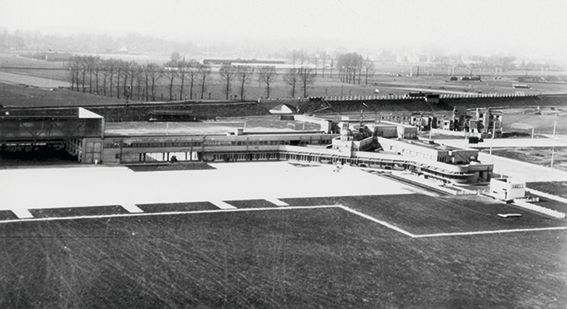
The recently completed airport building, just before its official opening in 1930. (coll. Dirk Buytaert)
Pushing boundaries
In the 1930s, many boundaries were pushed. The development of aviation went at a rapid pace and the aircraft became bigger and faster. Flying also provided unprecedented opportunities for reaching remote and lesser-known areas.
For Belgium the opportunity to reach its colony....
The airport was now part of a network connecting European cities. But to fly planes you also have to train pilots. The Antwerp Aviation Club fulfilled this task and several prominent figures made their appearance: among them Father Leon Bradfer who followed a pilot training with a colleague in 1937 before departing with two aircraft for the missions in the Belgian Congo. And then there was the Hansez-Fester couple, who flew from Antwerp to Leopoldville (now Kinshasa) on March 24, 1934.
On their return on April 11, they were honored by Antwerp Mayor Camille Huysmans. A new biplane was built at Stampe and Vertongen, which still writes history: the SV-4. Several air meetings were also organised. In 1938 we saw the first Douglas DC-3's arriving by ship in the port of Antwerp. They were assembled by Fokker personnel at Antwerp Airport. Due to the imminent threat of war, military pilots were stationed at Antwerp airport.
Belgium was ready...
Photo captions (top-left to bottom-right)
- Father Leon Bradfer ready for a training flight. (coll. Dirk Buytaert)
- A quick photo with a few people from the Antwerp Aviation Club. (coll. Dirk Buytaert)
- The Hansez-Fester couple are getting ready for departure. The bag with letters and postal items is brought on board. (coll. Dirk Buytaert)
- The Caudron Phalène and the crew are blessed, just before departure on October 22, 1937.
- Arrival in the Belgian Congo. The locals also want to have their picture taken. (coll. Dirk Buytaert)
- The route followed by Hansez-Fester to the Belgian Congo. (coll. Dirk Buytaert)
- Back in Antwerp, our pioneers are greeted by Mayor Camille Huysmans. (coll. Luchtvaart Antwerpen vzw)
- Some female members of the Antwerp Aviation Club. (left to right: Miss Mia Roosens, Miss Athie Stubbé, Mrs. Pierre Schellekens, Miss Martha Schellekens) (coll. Dirk Buytaert)
- The Stampe-Vertongen SV.4 of Elza Leysen was baptised in 1937 as OO-JAN, a reference to good friend and godfather Jan Olieslagers. (coll. Jean Dillen)
- Stunt flying by Guy Hansez, during one of the meetings in the thirties. (coll. Dirk Buytaert)
Stampe en Vertongen Museum vzw
Antwerp International Airport
Bus 3
B-2100 Antwerp-Deurne
Belgium
O.N. BE0447.236.613
RPR Antwerp
email: stampe@skynet.be
www.stampe.be
Opening hours individual visits
- Mon - Fri
- Closed
- Sat - Sun
- -
Closed on Easter Sunday and during August, December and January
Useful links
All rights reserved | Stampe en Vertongen Museum vzw






